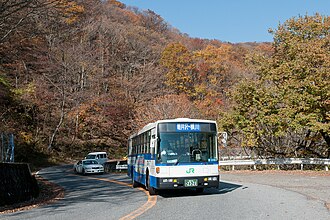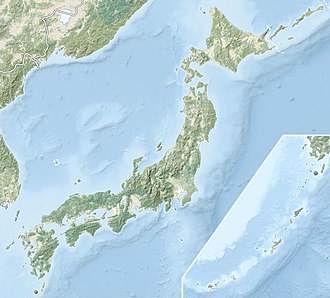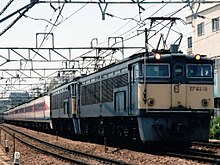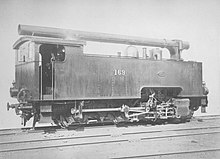Usui pass
| Usui pass | |||
|---|---|---|---|
|
Public bus on the Usui pass road |
|||
| Compass direction | west | east | |
| Pass height | 960 m TP | ||
| region | Nagano | Gunma | |
| Watershed | Japanese sea | Pacific | |
| Valley locations | Karuizawa | Annaka | |
| expansion | Pass road / railway | ||
| Mountains | Honshu | ||
| Map (Japan) | |||
|
|
|||
| Coordinates | 36 ° 20 ′ 41 ″ N , 138 ° 39 ′ 3 ″ E | ||
The Usui-pass ( Jap. 碓氷峠 , Usui-toge ) is a to 960 m TP situated mountain pass , the prefectures Nagano and Gunma in Japan together. It has been one of the most important traffic routes in Central Japan since the eighth century. From 1893, the then only cog railway in Japan ran over the Usui Pass. It was electrified in 1912 and replaced in 1963 by an adhesive membrane that has since been discontinued . Special locomotives have been developed for use on the cogwheel and adhesion railways.
Street
The route over the Usui Pass was mentioned as early as the 8th century in the Nihonshoki , where Yamatotakeru's journey to eastern Japan is described. During the Edo period , one of the five routes led over the pass.
The national road 18 , which leads over the Usui pass, serves as the main connection from the Kantō plain with the metropolitan area Tokyo to the tourist place Karuizawa . The original road was modernized with the construction of bypasses and the expansion into a motor road .
railroad
Rack railway

The Shin'etsu main line crossed the pass between 1893 and 1997. As early as 1888, a horse-drawn tram was put into operation on national road 18 on a trial basis to cope with the 500 meters of altitude. Traffic developed well, but the horses were strained and had to be changed twice on the 2½ hour journey. On March 24, 1891 began after the model of the resin sheet of the construction of the 11.2 km long railway line from Yokokawa (Gunma Prefecture) to Germany in Karuizawa (Nagano Prefecture) Self trasse and dreilamelliger rack system Abt . The Mino Owari earthquake on October 28, 1891 caused the bridges under construction to collapse. On December 22nd, 1892, construction work on the 11.2 kilometer long section with a 1:15 gradient (67 ‰), 18 bridges and 26 tunnels was completed and the line was opened on April 1st, 1893.

On the journey, which lasted more than an hour, the staff and passengers suffered from the exhaust fumes of the steam locomotives. To improve the air quality in the many tunnels, the rack section was electrified in 1912 with 600 volts direct current . In the tunnels, power was transmitted via a lateral conductor rail , outside via an overhead line .
On March 7, 1918, the 11-car freight train No. 191 derailed at Usui Pass. After the uphill train came to a standstill in a tunnel due to smoke from a traction motor, an auxiliary locomotive was requested. When trying to continue the journey, the freight train unrolled downhill and reached a speed of 32 instead of the permitted 18 km / h. In the Kumanotaira train station, the runaway composition derailed and hit a rock face. Two railway workers were killed at the scene of the accident, two of the six injured died later. The cause of the accident was the reduced effectiveness of the band brakes, contaminated by the oil from the defective drive motor .
Adhesion sheet
On July 15, 1963, the Japanese State Railways opened a new route with adhesion operation with a gradient of up to 67 ‰, which runs roughly parallel to the old rack and pinion route. On September 30th of the same year, the rack section was stopped. The standard trains of the Shin'etsu main line were now transported over the double-track steep section with six-axle electric locomotives of the JNR class EF63 . In 1997, on the occasion of the Winter Olympics in Nagano, the Hokuriku Shinkansen line, which runs under the pass with a tunnel, was opened. The JR East ceased operations on the pass route on October 1, 1997. The Usui-tōge Tetsudō Bunkamura museum is located on the site of the old depot in Yokokawa .
Locomotives
| Steam locomotives | 3900 | 3920 | 3950 | 3980 |
|---|---|---|---|---|
| Designation until 1894: until 1909: |
AD C1 |
AH C2 |
C3 |
|
| Numbering until 1894: until 1894: until 1909: from 1909 |
194, 196, 198, 200, 126, 128, 130, 132 500-503, 518-520 3900-3906 |
168, 169 504, 505 3920, 3921 |
506-511, 496-499, 3950-3959 |
512-517 3980-3985 |
| Manufacturer: | Esslingen | Beyer-Peacock | Kisha Seizo | |
| Commissioning: | 1892, 1908 | 1895 | 1898-1908 | 1906-1909 |
| Wheel alignment : | Czz | 1'Czz | 1'C1'zz | |
| Gauge : | 1067 mm ( cape track ) | |||
| Length over buffers: | 9100 mm | 9169 mm | 9804 mm | 9931 mm |
| Service mass: | 39.56 t | 56.13 t | 60.6 t | 55.9 t |
| Friction mass: | 39.56 t | 45.16 t | 42.1 t | 37.3 t |
| Wheel set mass : | 13.78 t | 16.05 t | 14.07 t | 13.41 t |
| Gear system : | Abbot (3 slats) | |||
|
Control type : tax. Gear drive: |
Heusinger Joy |
Heusinger Heusinger |
Heusinger Heusinger |
|
| Driving wheel diameter: diam. Drive gears: |
900 mm 573 mm |
914 mm 432 mm |
914 mm 559 mm |
|
| Cylinder diameter: cylinder d. Gear drive: |
390 mm 340 mm |
394 mm 298 mm |
394 mm 298 mm |
|
| Piston stroke: piston stroke gear drive: |
500 mm 400 mm |
508 mm 406 mm |
508 mm 406 mm |
|
| Boiler overpressure: | 12.4 kg / cm² | 12.4 kg / cm² | 12.7 kg / cm² | |
| Traction: | 84.6 kN | 84.6 kN | 91.3 kN | |
| Grate area: | 1.73 m² | 1.87 m² | 1.87 m² | |
| Evaporation heating surface: | 74.6 m² | 118.2 m² | 118.2 m² | |
| Water supply: | 3.48 m³ | 4.98 m³ | 6.65 m³ | |
| Coal supply: | 1.02 t | 1.72 t | 2.03 t | |
| Brakes: | Back pressure brake , vacuum brake , band brake , hand brake | |||
Steam locomotives
For the operation of the pass route, the Esslingen machine factory initially supplied four and in 1908 three more locomotives of the 3900 series for mixed adhesion and gear drive with the serial numbers 2502–2505 and 3510–3512. The three- coupling machines were equipped with an outer frame, two outer cylinders for the adhesion drive and two inner cylinders with simple steam expansion for gear drive. The adhesion drive working on the steep section supported the gear drive and relieved the rack. The commissioning of the first locomotives ordered by the state railways of Japan in Germany caused difficulties and the customer complained about the lack of support from the manufacturer. 1898 was also heavy oil to the boiler performance and reducing burners for improving the soot emissions with a box-shaped oil tank to the boiler installed. The second series was already equipped with this device upon delivery. After electrification in 1912, the machines remained in operation and were not scrapped until 1922.
The following steam locomotives came from Beyer-Peacock in Manchester. The 3920 series with internal gear drive , delivered in 1895 , was provided with a leading axis to increase the coal and water supplies and the water tanks were led to the front end of the boiler, which, however, was not conducive to the elegance of the two machines from Great Britain. The locomotives carried a tensile load of 100 to 200 t on the adhesion section with a 25 ‰ gradient and on the rack section at a speed of 8 km / h. On delivery, the machines had a T-shaped chimney to protect the locomotive personnel from the exhaust gases. The device with which the smoke could optionally be led to the top or the end of the locomotive was later removed. A condensation device similar to that used on the London Underground led from the exhaust pipe into the plenum chamber and was intended to reduce emissions . Around 1909 the locomotives received a heavy oil furnace with an oil tank on the boiler. Machine number 3920 was scrapped in 1917, the other locomotive was destroyed by the Great Kanto earthquake in 1923 .
The locomotives of the 3950 series were slightly larger and had an additional running axle under the tender. The T-chimney and condensation device as in the 3920 series was omitted. The machines were delivered in three part series:
● 1898 No. 506–509 (from 1909 No. 3950–3953)
● 1901 No. 510, 511 (from 1909 No. 3954, 3955)
● 1908 No. 496–499 (from 1909 No. 3956–3959)
From 1901 the locomotives were equipped with additional heavy oil firing. After the electrification of the rack-and-pinion line, the machines, with the exception of 3951, remained in operation until 1921. 3951 burned out in the Great Kanto earthquake in 1923. It was restored as a memorial until it fell victim to the war-related shortage of materials in 1941.
The rivalries with Russia and the resulting war led to an increase in traffic over the Usui Pass and a greater need for cogwheel locomotives. The machines required were manufactured as the 3980 series by the local manufacturer Kisha Seizo. They largely corresponded to the 3950 series originating from Great Britain. Externally, they differed from their predecessors with round rivets with the countersunk head screws . The delivery was again in three lots : ● 1906 No. 512, 513 (from 1909 No. 3980, 3981) ● 1908 No. 514, 515 (from 1909 No. 3982, 3983) ● 1909 No. 3984 and 3985
The heavy oil firing with the tank on the boiler was already in place on delivery. Number 3983 remained in service until 1919, the other locomotives were retired in 1917.
Electric locomotives
| Electric locomotives | EC40 | ED40 | ED41 | ED42 | EF63 |
|---|---|---|---|---|---|
| Numbering until 1928: from 1928 |
10000-10011 EC401-EC4012 |
10020-10033 ED401-ED4014 |
10040, 10041 ED411, ED 412 |
ED421-ED4214 |
EF631-EF6325 |
| Manufacturer: | AEG , Esslingen | Ōmiya, BBC | SLM , BBC |
Hitachi , Toshiba , Kawasaki , Mitsubishi , Kisha Seizo |
Toshiba, Mitsubishi, Kawasaki, Fuji |
| Commissioning: | 1911 | 1919-1923 | 1926 | 1934-1948 | 1962-1976 |
| Retirement: | 1936 | 1952 | 1951 | 1963 | 1997 |
| Wheel alignment : | Czz | Dzz | B'zzB ' | B 0 'B 0 ' B 0 ' | |
| Gauge : | 1067 mm ( cape track ) | ||||
| Length over buffer / coupling: | 9550 mm | 9924 mm | 12 800 mm | 12 810 mm | 18,050 mm |
| Service / adhesion weight : | 46 t | 60.7 t | 59.85 t | 62.52 t | 108.0 t |
| Top speed: | 25.0 km / h (rack 18.0 km / h) | 100 km / h | |||
| Hourly output : | 420 kW | 940 kW | 525 kW | 510 kW | 2550 kW |
| Hourly pulling force: rack and pinion distance: |
55 kN 110 kN |
56 kN 112 kN |
116 kN 143 kN |
91 kN 137 kN |
230 kN |
| Gear system : | Abbot (3 slats) | - | |||
| Power system : | 600 V = | 1500 V = | |||
| Power transmission: | Overhead line , conductor rail | Overhead line | |||
| Brakes: |
Electric brake , air brake , band brake , hand brake |
Electric brakes , air brakes , band brakes , hand brakes , adhesive wheels, hand brakes, drive gears |
El. Brake , compressed air brake, magnetic rail brake |
||
The EC40 series with separate adhesion and gear drive was delivered in 1911 by AEG and Maschinenfabrik Esslingen . The twelve locomotives with short front and rear stems had a driver's cab on both sides when they were delivered . The traction current flowed from one of the two trolley pantographs to the two traction motors installed in the engine room. One served the gear drive on the rack and pinion section, the other drove the three axes on adhesion and rack sections via a gear and rod drive . The vacuum brake was later replaced by an air brake . The driver's cab on the Karuizawa side was removed and replaced by accumulators , which were the only power source to supply the low-voltage consumers and the compressor . There was no charging device on the locomotive, the accumulators mounted on rollers were exchanged and charged in a stationary manner.
The locomotives were only used on the mountain route between Yokokawa and Karuizawa. In 1936 the machines were taken out of service. Four locomotives then came to the Kyoto tram , where the EC40 1 and EC40 2 were refurbished and the gear drive and one of the two stems removed. The other two machines served as spare parts dispensers. In 1964 one of the locomotives came back to the Japanese State Railways , which returned it to its original condition. Since then it has been reminiscent of the cog railway over the Usui Pass in Karuizawa as machine no.
The concept of the ED40 series corresponded to its three-axis predecessor EC40, but was expanded to four axes. The front end and a second driver's cab on the Karuizawa side were dispensed with. The mechanical part was supplied by the Japanese manufacturer Ōmiya in Saitama , the electrical equipment came from Brown, Boveri & Cie. (BBC) in Switzerland. The locomotives were delivered for five years:
● 1919 No. 10020–10023 (from 1928 ED40 1 – ED40 4)
● 1920 No. 10024–10027 (from 1928 ED40 5 – ED40 8)
● 1921 No. 10028–10030 (from 1928 ED40 9 – ED40 11)
● 1922 the no. 10031, 10032 (from 1928 ED40 12, ED40 13)
● 1923 the no. 10033 (from 1928 ED40 14)
The use of the ED40 series was limited to the busy mountain route over the Usui Pass. After the delivery of the ED42 class, the locomotives from the 1920s were no longer needed and were decommissioned between 1943 and 1951. Some then ended up on various private railways , where the gear drive was removed for the new areas of application. ED40 10 was restored in 1968 and exhibited in front of the company building of its manufacturer Ōmiya. In 2007 the gear drive was reconstructed. Since then, the machine is near the train station Ōmiya nearby railway museum display.
In 1926 the Schweizerische Lokomotiv- und Maschinenfabrik (SLM, serial numbers 3120 and 3121/1925) and BBC supplied the two locomotives of the technically highly developed 10040 series , and from 1928 the ED41 series with separate adhesion and gear drive. The mechanical part with rod drive was based on the Be 4/6 of the SBB and was supplemented with a gear drive, which was located between the two adhesion bogies . The air brake air reservoir was on the roof above the only driver's cab. The three traction motors , two for the adhesion drive and one for the gear drive, each had an hourly output of 200 kW. As was common with direct current locomotives at the time, they were controlled via series resistors. The locomotives were equipped with a facility for charging the accumulators, so that their number could be greatly reduced. The machines served as prototypes of the ED42 series and remained in use until 1951.
Due to the further increase in traffic and to replace old locomotives, various Japanese manufacturers built the SLM locomotive as the ED42 series between 1937 and 1947 . As was common in Japan at the time, the replica was made without a license . Compared to the original, the control of the compressed air brake and the recuperation brake has been changed. The latter enabled electricity savings of 30%. The first four machines were delivered in 1934, and a further 18 followed by the outbreak of World War II. Due to the lack of material during the war, some design changes were made when building another 6 locomotives.
The machines remained in operation until the cog railway was discontinued in 1963. ED42 1 was restored in 1967 and is now on display in the Usui-tōge Tetsudō Bunkamura theme park in Yokokawa. ED42 2 stands in front of a primary school in Karuizawa.

For the bias and coasting on the 1963 opened Adhäsionsstrecke the procured Japanese National Railways , the locomotive EF63 series in several series:
● In 1962, the pre-production locomotive EF63 1
● In 1963, the first series locomotive EF63 2-13
● 1966 to 1969, the second series locomotive EF63 14-21
● 1974 and in 1976 the third series EF63 22-25
The six-axle direct current locomotives were derived from the EF60 series and adapted to the special requirements of the steep section . A powerful resistance brake , recognizable by the large cooling air grilles on the side walls, a magnetic rail brake , a roll-back protection device and speed monitoring ensured safety. Cab front doors enabled the staff to pass through the locomotives, which always run in double traction . An extensive multiple control made multiple traction possible with different multiple unit series. With the discontinuation of steep sections, the EF63 lost its field of application. Several locomotives have been preserved, EF63 1 was given the original brown paint and is in the Usui-tōge Tetsudō Bunkamura theme park .
swell
Road and railway line
- Kurata Tadaschi: 峠 物語 碓 氷 峠. History of the Usui Pass. Road No. 464. Nippon Highway Association, 1979, 65-70 (Japanese)
- Hiroshi Kubota: 日本 の 鉄 道 史 セ ミ ナ ー. Seminar on the railway history of Japan. Grand Prix Verlag, 2005. ISBN 978-4876872718 (Japanese)
- Jirō Tajima 鉄 路 4 代 - 碓 氷 峠 を 越 え て. Fourth Railway - Over the Usui Pass. In Journal of the Japanese Society of Civil Engineers, Vol. 83, No. 3. Civil Engineering Society , 1998, pages 10-11 (Japanese)
- Masahiro Maki: 信 越 線 横 川 - 軽 井 沢 間 の 電 気 機関 車 と 電車 の 協調 運 転. Electric rail operation between Yokokawa and Karuizawa. In: The Railway Pictorial No. 213. Denkisya Kenkyukai Co., August 1968 (Japanese)
- Walter Hefti: The world's rack railways. Birkhäuser Verlag Basel and Stuttgart 1971, ISBN 3-7643-0550-9
- Teikoku's Complete Atlas of Japan. Teikoku-Shoin Co., Tokyo, 1990 (English)
Locomotives
- Shigenobu Usui: 日本 蒸 気 機関 車 形式 図 集成. Series of Japanese steam locomotives. Seibundo Shinkosha, 1969 (Japanese)
- Shigenobu Usui: 機関 車 の 系譜 図 1. Development of locomotives 1. Koyusha & Co. Ltd., 1972 (Japanese)
- Shigehiro Kaneda: 日本 蒸 気 機関 車 史 官 設 鉄 道 編. History of the Japanese steam train. Kōyū-sha, 1972 (Japanese)
- Shigehiro Kaneda: 形式 別 国 鉄 の 蒸 気 機関 車 II. Series of JNR steam locomotives II. Eriei Railway Publishing and Press Department, 1984 (Japanese)
- Yukiyoshi Kawakami: 私 の 蒸 気 機関 車 史 上. On my story of the steam locomotive. Kōyū-sha, 1978 (Japanese)
- Takao Takada (Ed.): 万 有 ガ イ ド シ リ ー ズ 12 蒸 気 機関 車 日本 編. Bulletin Series 12: Japanese Steam Locomotive. Shogakukan Inc., 1981 (Japanese)
- Fuyu Hidaka: 碓 氷 峠 の ア プ ト 式 電 気 機関 車. Electric cogwheel locomotives from Usui Pass. 比 古 の 電 気 機関 車 発 達 史. History of the development of electric locomotives. From: http://ktymtskz.my.coocan.jp/ , accessed December 1, 2017 (Japanese)
-
EF63 :
- Hiroshi Kubota: 日本 の 鉄 道 史 セ ミ ナ ー. Seminar on the railway history of Japan. Grand Prix Verlag, 2005. ISBN 978-4876872718 (Japanese)
- Katsuhisa Fujimoto: 直流 新 形 電機 出生 の 記録 8. Development of the new type 8 electric machine. In: Japan Railfan Magazine No. 304, issue 8/1986, Koyusha Co., Ltd., pages 62-67 (Japanese)
- EF62 ・ 63 形 電 気 機関 車. Electric locomotive EF62 / 63. In: 電 気 車 の 科学. Science electric drive, issues 10/1962 and 12/1965. Denkisya Kenkyukai Co. Ltd. (Japanese)
- 鉄 道 ピ ク ト リ ア ル: 碓 氷 峠. Railway pictures: Usui Pass. In: 電 気 車 の 科学. Science electric drive No. 494, issue 4/1988. Denkisya Kenkyukai Co. Ltd. (Japanese)
- San'ei Shobō: 鉄 道 車 両 の テ ク ノ ロ ジ ー. Rail vehicle technology. Vol. 11, August 4, 2011. ISBN 978-4-7796-1252-7 (Japanese)
Individual evidence
- ↑ 鉄 道 災害 記事. 自大 正 4 至 6 年度. Railway disasters during the Taishō period , 4th – 6th centuries Fiscal year. Secretariat of the Ministry of Research, 1926
- ^ A b c Rolf Höhmann: Technology transfer in the railway system of Japan. In: Ferrum. News from the Iron Library, Georg Fischer AG Foundation, Volume 82 (2010), Pages 41–46 (E-Periodica.ch, PDF; 5.5 MB).
- ↑ 1C1 2zt cogwheel locomotive of the Japanese state railways In: Die Lokomotive , 1910, issue 7, pages 164–165
- ↑ Asakura Kiichi: 思 い 出 話. Memories speak. In: Rail No. 4, July 1978
- ^ Rail Magazine 153, Neko-Verlag, 1996, page 49
- ^ Kaspar Vogel: The Swiss Locomotive and Machine Factory 1871–1997. Minirex, Luzern 2003, ISBN 3-907014-17-0














